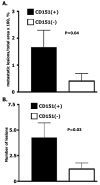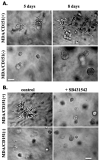Tetraspanin CD151 regulates transforming growth factor beta signaling: implication in tumor metastasis
- PMID: 20570898
- PMCID: PMC6485427
- DOI: 10.1158/0008-5472.CAN-09-3497
Tetraspanin CD151 regulates transforming growth factor beta signaling: implication in tumor metastasis
Abstract
Tetraspanin CD151 is associated with laminin-binding integrins and controls tumor cell migration and invasion. By analyzing responses of breast cancer cells to various growth factors, we showed that depletion of CD151 specifically attenuates transforming growth factor beta1 (TGFbeta1)-induced scattering and proliferation of breast cancer cells in three-dimensional Matrigel. CD151-dependent cell scattering requires its association with either alpha3beta1 or alpha6 integrins, but it is independent of the recruitment of CD151 to tetraspanin-enriched microdomains. We also found that CD151 regulates the compartmentalization of TGF-beta type I receptor (TbetaRI/ALK-5) and specifically controls the TGFbeta1-induced activation of p38. In contrast, signaling leading to activation of Smad2/3, c-Akt, and Erk1/2 proteins was comparable in CD151(+) and CD151(-) cells. Attenuation of TGFbeta1-induced responses correlated with reduced retention in the lung vascular bed, inhibition of pneumocyte-induced scattering of breast cancer cells in three-dimensional Matrigel, and decrease in experimental metastasis to the lungs. These results identify CD151 as a positive regulator of TGFbeta1-initiated signaling and highlight the important role played by this tetraspanin in TGFbeta1-induced breast cancer metastasis.
(c)2010 AACR.
Figures






Similar articles
-
CD151 accelerates breast cancer by regulating alpha 6 integrin function, signaling, and molecular organization.Cancer Res. 2008 May 1;68(9):3204-13. doi: 10.1158/0008-5472.CAN-07-2949. Cancer Res. 2008. PMID: 18451146 Free PMC article.
-
Tetraspanin CD151 regulates growth of mammary epithelial cells in three-dimensional extracellular matrix: implication for mammary ductal carcinoma in situ.Cancer Res. 2010 Jun 1;70(11):4698-708. doi: 10.1158/0008-5472.CAN-09-4330. Epub 2010 May 25. Cancer Res. 2010. PMID: 20501858 Free PMC article.
-
CD151 regulates tumorigenesis by modulating the communication between tumor cells and endothelium.Mol Cancer Res. 2009 Jun;7(6):787-98. doi: 10.1158/1541-7786.MCR-08-0574. Epub 2009 Jun 16. Mol Cancer Res. 2009. PMID: 19531562
-
CD151 in cancer progression and metastasis: a complex scenario.Lab Invest. 2014 Jan;94(1):41-51. doi: 10.1038/labinvest.2013.136. Epub 2013 Nov 18. Lab Invest. 2014. PMID: 24247563 Review.
-
The tetraspanin CD151 in papillomavirus infection.Viruses. 2014 Feb 18;6(2):893-908. doi: 10.3390/v6020893. Viruses. 2014. PMID: 24553111 Free PMC article. Review.
Cited by
-
Tetraspanins Function as Regulators of Cellular Signaling.Front Cell Dev Biol. 2017 Apr 6;5:34. doi: 10.3389/fcell.2017.00034. eCollection 2017. Front Cell Dev Biol. 2017. PMID: 28428953 Free PMC article. Review.
-
CD151 represses mammary gland development by maintaining the niches of progenitor cells.Cell Cycle. 2014;13(17):2707-22. doi: 10.4161/15384101.2015.945823. Cell Cycle. 2014. PMID: 25486358 Free PMC article.
-
Tetraspanin CD151 expression associated with prognosis for patients with advanced gastric cancer.J Cancer Res Clin Oncol. 2013 Nov;139(11):1835-43. doi: 10.1007/s00432-013-1503-4. Epub 2013 Sep 5. J Cancer Res Clin Oncol. 2013. PMID: 24005419 Free PMC article.
-
Integrin α3β1 as a breast cancer target.Expert Opin Ther Targets. 2011 Oct;15(10):1197-210. doi: 10.1517/14728222.2011.609557. Epub 2011 Aug 13. Expert Opin Ther Targets. 2011. PMID: 21838596 Free PMC article. Review.
-
Upregulation of HIF1-α via an NF-κB/COX2 pathway confers proliferative dominance of HER2-negative ductal carcinoma in situ cells in response to inflammatory stimuli.Neoplasia. 2020 Nov;22(11):576-589. doi: 10.1016/j.neo.2020.09.003. Epub 2020 Sep 25. Neoplasia. 2020. PMID: 32980776 Free PMC article.
References
-
- Berditchevski F. Complexes of tetraspanins with integrins:more than meets the eye. J Cell Sci. 2001;115:4143–51. - PubMed
-
- Hemler ME. Tetraspanin functions and associated microdomains. Nat Rev Mol Cell Biol. 2005;6:801–11. - PubMed
-
- Baldwin G, Novitskaya V, Sadej R, et al. Tetraspanin cd151 regulates glycosylation of alpha3beta1 integrin. J Biol Chem. 2008;283:35445–54. - PubMed
Publication types
MeSH terms
Substances
Grants and funding
LinkOut - more resources
Full Text Sources
Other Literature Sources
Medical
Miscellaneous

